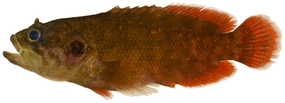Pseudogramma
Pseudogramma is a genus of fishes in the family Serranidae. They live on coral reefs and exhibit cryptic colors and patterns to conceal them.[1]
| Pseudogramma | |
|---|---|
 | |
| Pseudogramma gregoryi | |
| Scientific classification | |
| Kingdom: | |
| Phylum: | |
| Class: | |
| Order: | |
| Family: | |
| Genus: | Pseudogramma Bleeker, 1875 |
Species
There are currently 14 recognized species in the genus:
- Pseudogramma astigma J. E. Randall & C. C. Baldwin, 1997 (Spot-less podge)
- Pseudogramma australis J. E. Randall & C. C. Baldwin, 1997 (Pascua podge)
- Pseudogramma axelrodi G. R. Allen & D. R. Robertson, 1995
- Pseudogramma brederi (Hildebrand, 1940) (Confused podge) [2]
- Pseudogramma erythrea J. E. Randall & C. C. Baldwin, 1997 (Caban podge)
- Pseudogramma galzini J. T. Williams & Viviani, 2016 (Galzin's podge) [2]
- Pseudogramma gregoryi (Breder, 1927) (Reef podge)
- Pseudogramma guineensis (Norman, 1935)
- Pseudogramma megamyctera J. E. Randall & C. C. Baldwin, 1997 (Big-nostril podge)
- Pseudogramma paucilepis J. T. Williams & Viviani, 2016 (Weak-scaled podge) [2]
- Pseudogramma pectoralis J. E. Randall & C. C. Baldwin, 1997 (Pectoral podge)
- Pseudogramma polyacantha (Bleeker, 1856) (Pale-spot podge)
- Pseudogramma thaumasia (C. H. Gilbert, 1900) (Pacific reef podge)
- Pseudogramma xantha J. E. Randall, C. C. Baldwin & J. T. Williams, 2002 (Yellow podge)
gollark: To advance the cause of neglection science and whatnot.
gollark: Would you mind trying to get the view count on each turn?
gollark: And yes.
gollark: This is ridiculous.
gollark: I'm alt-tabbing between this and Minecraft, but you know.
References
- Froese, Rainer and Pauly, Daniel, eds. (2016). Species of Pseudogramma in FishBase. January 2016 version.
- Williams, J.T. & Viviani, J. (2016): Pseudogramma polyacantha complex (Serranidae, tribe Grammistini): DNA barcoding results lead to the discovery of three cryptic species, including two new species from French Polynesia. Zootaxa, 4111 (3): 246–260.
This article is issued from Wikipedia. The text is licensed under Creative Commons - Attribution - Sharealike. Additional terms may apply for the media files.